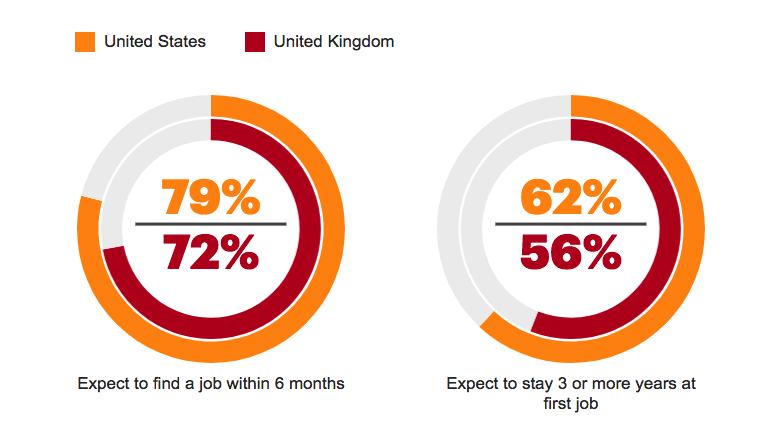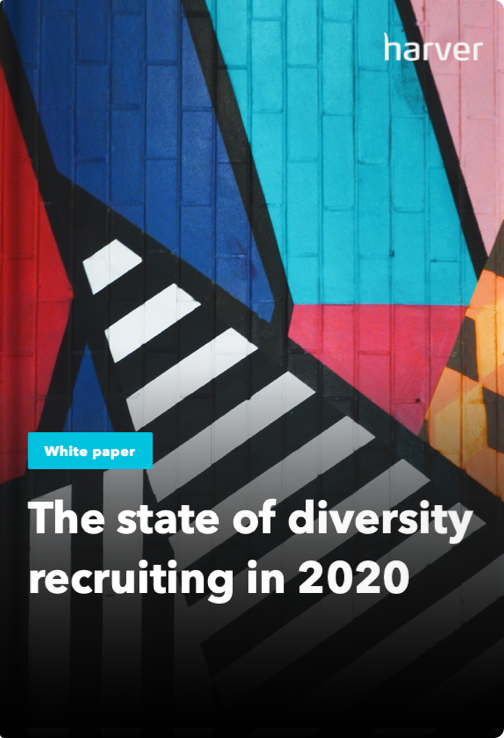Around 25% of fresh graduates quit their first job before their one-year anniversary.
A recent survey showed that this number is even higher in Southeast Asia. Over one-third of all entry-level hires in Malaysia or the Philippines leave their position before hitting the one-year mark.
Unfortunately, this leaves both the employer and the employee at a disadvantage.
Graduation can be a complicated time for anyone. Not only are students focused on finishing finals and wrapping up their education; they’re also tasked with finding a job. For many, the pressure to enter the workforce is so high that they accept the first position that comes their way.
It’s not until they’re well into the day-to-day responsibilities that they realize it doesn’t really fit their needs.
The companies that hire these recent grads are left picking up the pieces.
Not only have they wasted time and money investing in an employee who wasn’t the right fit, but they also need to start the recruitment process all over again. This is expensive, time-consuming, and inefficient – potentially holding the entire business back from flourishing.
However, hiring new graduate employees doesn’t mean you’re destined to become trapped in a revolving door of new hires. It does mean you need to be strategic about who you’re hiring in the first place.
Like what you see?
Don’t miss out. Subscribe to our quarterly digest to get the latest TA and TM resources delivered right to your inbox.
There are a few things companies can do to improve their graduate recruitment strategy to hire better new grad employees the first time around. First, let’s take a look at why graduates leave their first jobs early.
Expectations of fresh graduates

Although over a half of recent graduates expect to stay 3 or more years at their first job, it is rarely the case.
Why is Graduate Turnover So High?
Hiring new grads can come with a lot of benefits. Not only are they eager to start their career, but they also bring fresh perspectives, ideas, and philosophies.
However, they also come with unique needs.
Here are some of the biggest reasons new graduates might leave a job within the first year.
Lack of Skill or Confidence
It’s easy for a recent graduate to feel in over their heads when entering the workforce. While they might have experience in a part-time position or internship, applying their education to a full-time position can feel challenging.
Many employees new to the workforce may feel unprepared for the daily responsibilities that go with the job. If they don’t have the confidence or skill to get the job done appropriately, they may turn to a position that is a bit more lenient.
Misaligned Job Expectations
If an employee has never been in a full-time position before, they may not know entirely what to expect. Additionally, as a new employee, there may be some not-so-fun tasks that recent grads don’t expect to have to complete.
A fresh graduate may choose to leave a position because the job expectations weren’t clear before starting. If they’re not happy with the responsibilities or expectations, they may look elsewhere for a better fit.
According to a survey from Accenture, the number of recent graduates who consider themselves underemployed has grown to whopping 54%.
Insufficient Research
Unfortunately, many new grads may be tempted to take the first offer that comes their way because they’re scared they won’t have any alternatives. When this happens, they’re unlikely to research the company, the job, or the responsibilities.
Without doing the proper research before starting the job, new hires may find that their values don’t align with the organization they’re working for. They may also discover that the company doesn’t have benefits, programs, or resources they need, pushing them to look for a new position.
Few Development Opportunities
New graduates are typically excited about starting their career and many want to advance as quickly as possible. However, their development typically depends on the company and the growth opportunities they offer.
New employees may be quick to leave if there are not clear paths or opportunities for them to develop or move to a higher role. They may also want to leave if the company doesn’t seem to invest in education, personal development, or leadership.
Absence of Mentorship
Transitioning from a student to an employee isn’t always smooth. In many situations, new graduates may be looking for some help or guidance on how to adjust.
If new hires aren’t given mentors, the process can be even more difficult. Lack of mentorship could be another reason why recent grad turnover is higher for certain organizations.
Although all of this might sound scary, there are steps you can take to address these problems and make your graduate recruitment strategy more successful.
Steps to Improve Your Graduate Recruitment Strategy
In most cases, recent graduates quit their first job because there was a mismatch between their expectations and reality. While it’s common for new hires to take a bit of time to adjust to the working world, you can reduce your graduate turnover by improving your recruitment process.
Here are a few ways you can make your recruitment process stronger so you can reduce turnover.
1. Set Clear Requirements, Expectations, and Benefits
Anytime you post a new job opening, you want to be clear about your requirements and expectations. By creating solid job descriptions, you can ensure each applicant knows exactly what they’re signing up for. This can reduce confusion, guaranteeing you’re putting a qualified individual in your open position.
You should also outline any benefits you offer either in the job description or on your website. By being upfront about health insurance, paid time off, or other bonuses, candidates won’t be caught off guard with a benefits package that doesn’t fit their needs.
2. Provide Development and Education Opportunities
New graduates are excited about starting their careers, so they’ll want to enter a job that can get them started on the right foot. By providing continued education or development opportunities, you’ll let new hires know their growth is important to you.
Investing in new graduates can help them stick around longer. When they feel valued and pushed to do better, they’ll be more likely to stay with your company. Provide clear promotion pathways so new graduates can see just how they can develop their careers with your company.
Current graduates expect having training and development opportunities provided by their first employer.
3. Create an Employer Brand
Just like a company brand is important for attracting high-quality customers, an employer brand can help you attract the best quality job candidates. A strong employer brand lets new applicants better understand who is behind your business, letting them see if it is the right fit for them before applying.
Your employer brand should showcase your company culture, current team members, and the values your employees work by. By sharing some of these stories, you can create a strong image of exactly the kind of people you want on your team, reducing friction when hiring new employees.
4. Use Multiple Recruitment Methods
When hiring new graduates, job fairs and campus recruiting is a great way to attract qualified candidates looking for a job right out of school. However, you’ll want to do more than just attend a few hiring events. When trying to get younger individuals to apply, you’ll want to recruit online as well.
Social media can be a great tool for recruiting new graduates. While LinkedIn might be the first platform you think of, Facebook, Twitter, and even Instagram and Snapchat can help you attract high-quality candidates. Participating in conversations, sharing open positions, and even showcasing your employer brand across your social platforms can help encourage new grads to apply.
The state of diversity recruiting in 2020
5. Have an Intern Hiring Program
An intern program can be a great pipeline for finding strong new graduate talent. Because your interns are given an inside look at the day-to-day operations of your business, you’ll both know if they fit your needs before they accept a full-time position.
Develop a strong internship program and let your interns know there is an opportunity for full-time employment after graduation. Setting this precedent can encourage interns to work hard and show off their skills, guaranteeing you’re getting the best graduate hires.
6. Track and Monitor Recruitment Data
To make smarter hiring decisions, take a look at what recruitment efforts have worked for new graduates in the past. By keeping extensive records of what graduates you’re engaging with and what hires have been the best fit for your company, you can improve connections moving forward.
Use data to identify the best schools, majors, or areas to recruit new graduates from. You can also use data to monitor different recruitment methods, such as identifying what platforms or processes you find the best applicants from. When you find what works, you can make more strategic decisions moving forward.
7. Keep in Touch with Applicants
New graduates typically talk with a few different companies when looking for their first full-time position. This means it isn’t uncommon to have a high-quality candidate accept a job with another company. However, this doesn’t mean you need to give up on that individual completely.
Sometimes, the high turnover for new graduates can work in your favor. A high-quality candidate may accept a position with another company only to find it isn’t the right fit. If you keep in touch consistently, they may choose to come to you next. Simply sending a message every couple months to check in can keep you top of mind.
Unemployment rate of recent graduates in the U.S.
Unemployment rate of recent graduates in many countries including the U.S. is very low, so it is important to maintain a potential talent pool.
8. Create a Referral Network
Employer referrals can be a great way to get quality candidates, especially when it comes to attracting new hires. By encouraging your current employees, friends, or family to inform your HR department of new graduates who might be a fit for an open position, you can narrow in on candidates who fit your needs the most.
Current employees will know exactly the kind of individuals you’re looking to hire, so they’ll recommend employees who already fit the culture. Offer incentives, such as a bonus or an extra day off, to employees who make referrals that are ultimately hired.
9. Feature Former Graduate Hire Testimonials
When new graduates are researching companies to work with, they’ll want to understand how companies have connected with new graduates in the past. By sharing some insights into past graduate hires’ experiences with your company, new prospects can get a better idea if you’re the fit they’re looking for.
Featuring former graduate hire testimonials on your careers page is one way you can connect with new applicants. You can also have high-quality candidates talk with former graduate hires during the interview process, giving them the ability to ask any questions or address any concerns they might have.
Building a Strong Graduate Recruitment Strategy
When hiring recent grads, it’s important both of you are on the same page about the job expectations and company culture. By developing a strong graduate recruitment strategy, you can ensure you’re hiring the right individuals and reduce your graduate turnover.
Look for unique methods to connect with your ideal candidates and use data to analyze who your best graduate applicants are and where they are coming from. Connect with your network to get referrals and use past graduate hires to develop connections with your top talent.
The graduate recruitment strategy that works for your business will depend on your unique needs and the talent you’re trying to attract. However, you can use these methods as a jumping off point to get your graduate recruitment strategy started.
The state of diversity recruiting in 2020




